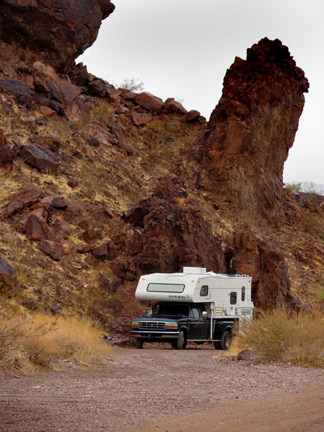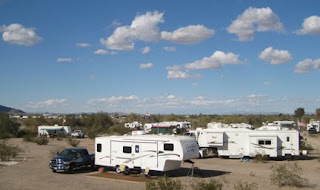A bill passed this week by the Arizona legislature will lead ultimately to the closure of all state parks, according to the Arizona State Parks Foundation, including those along the Colorado River such as Buckskin Mountain, River Island, Cattail Cove and Lake Havasu State Park - Windsor Beach.

The bill cuts more than $9 million of Parks funds, leaving the agency with only about $10 million in its 2010 budget. That’s less than 30 percent of the agency’s normal funding and not enough to continue park operations beyond this fiscal year.
Arizona Governor Jan Brewer and the Arizona legislature are seeking $205 million in cuts to mitigate a deficit estimated to be $1.5 billion. The Foundation says the proposed cuts to State Parks would provide just 4 percent of their goal, while shutting down the Park’s annual contribution to the Arizona economy of more than $266 million (much of which is generated in busy parks like those in the Parker area).
The cuts will force major reductions in Parks staff and closure of more than half of the State’s 30 parks this fiscal year. The resulting loss of Park revenue is projected to leave the Parks System with no money to start the next fiscal year, July 1, 2010. The next step would be to shut down the entire system and dispose of Parks properties, returning most of them to their original owners.
The Foundation’s website now contains an “urgent call to action”, saying:
If legislatures could keep parks open to Arizonans through 50 years of prior downturns, wars, gas crises and political turmoil, surely current lawmakers can find the revenues to do so–-especially given the great economic value, popularity and intrinsic worth of our state parks.
If you or your children wish to ever visit such extraordinary places like Kartchner Caverns State Park, Tonto Natural Bridge State Park, or Tubac Presidio State Historic Park, you must act today. It is our last hope.
According to the Foundation, the last hope for keeping State Parks open is a line-by-line veto by Governor Brewer of the Parks cuts in the bill. They are appealing to the Governor to do this and ask that the public do the same.
 Charlie Cassens, Lake Havasu City's interim city manager is quoted in the Arizona Republic, "We're ready to do whatever's necessary to keep Lake Havasu State Park open for our residents and our visitors," he said. "That is a vital and integral part of this community's economy." State officials will meet this Thursday to deliberate whether or not to turn control of the popular park over to the city. With nearly 250,000 visitors a year, a closure would certainly mean a hit on tourism revenues.
Charlie Cassens, Lake Havasu City's interim city manager is quoted in the Arizona Republic, "We're ready to do whatever's necessary to keep Lake Havasu State Park open for our residents and our visitors," he said. "That is a vital and integral part of this community's economy." State officials will meet this Thursday to deliberate whether or not to turn control of the popular park over to the city. With nearly 250,000 visitors a year, a closure would certainly mean a hit on tourism revenues. The bill cuts more than $9 million of Parks funds, leaving the agency with only about $10 million in its 2010 budget. That’s less than 30 percent of the agency’s normal funding and not enough to continue park operations beyond this fiscal year.
The bill cuts more than $9 million of Parks funds, leaving the agency with only about $10 million in its 2010 budget. That’s less than 30 percent of the agency’s normal funding and not enough to continue park operations beyond this fiscal year. The discovery of the small and beautiful valley between Pine and Payson was documented in 1877 by David Gowan, a prospector who stumbled across the bridge as he was chased by Apaches. Gowan hid for two nights and three days in one of several caves that dot the inside of the bridge. On the third day, he left the cave to explore the tunnel and green valley surrounding it. Gowan then claimed squatter's rights.
The discovery of the small and beautiful valley between Pine and Payson was documented in 1877 by David Gowan, a prospector who stumbled across the bridge as he was chased by Apaches. Gowan hid for two nights and three days in one of several caves that dot the inside of the bridge. On the third day, he left the cave to explore the tunnel and green valley surrounding it. Gowan then claimed squatter's rights.







 At the turn of the twentieth century, when auto travel was becoming the rage, Yuma, Ariz., was at a crossroads but with a big obstacle to the west: sand dunes -- vast sand dunes.
At the turn of the twentieth century, when auto travel was becoming the rage, Yuma, Ariz., was at a crossroads but with a big obstacle to the west: sand dunes -- vast sand dunes. The first such road was constructed in 1915 and was rapidly replaced by a second one in 1916. The San Diego Chamber of Commerce, eager for the business the road could bring, donated 13,100 oak planks. The second road was built in eight-foot by twelve-foot sections and reinforced with strap iron along the edges and centers. The speed limit was 10 miles per hour.
The first such road was constructed in 1915 and was rapidly replaced by a second one in 1916. The San Diego Chamber of Commerce, eager for the business the road could bring, donated 13,100 oak planks. The second road was built in eight-foot by twelve-foot sections and reinforced with strap iron along the edges and centers. The speed limit was 10 miles per hour.






